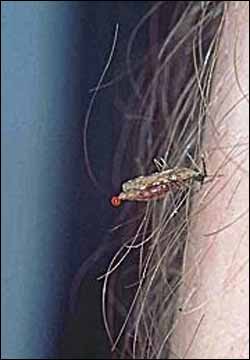Research team discovers hormone that causes malaria mosquito to urinate

When a mosquito sucks blood from a human, it will take in twice its body weight in blood. To decrease this added weight, the mosquito urinates on its victim to release fluids. Stimulation of this process when the mosquito is not feeding could make the mosquito die. Photo courtesy of Geoff Coast, University of London.
Discovery has implications for control of mosquitoes, malaria and West Nile Virus
Prior to coming to Nevada 16 years ago, David Schooley was a key figure at a small company in Palo Alto, Calif. that developed methoprene, an insecticide that halts the maturation of insect larvae to adults.
Methoprene, which has the same effect as an insect hormone called juvenile hormone, also stops the insect from reproducing. It is being used heavily throughout the United States to help prevent the spread of West Nile Virus.
Schooley’s contribution to the development of methoprene was to prove that it is harmless to animals and the environment.
“Table salt is far more toxic,” said Schooley, a professor of biochemistry at the University of Nevada, Reno’s College of Agriculture, Biotechnology and Natural Resources
The problem with methoprene, however, is that for a species such as the tobacco hornworm, methoprene causes it to grow larger instead of transforming into a moth, enhancing the pest’s ability to devastate crops.
“It’s not a great way to sell an insecticide to a farmer,” Schooley said. “Most money in pesticide development is in making insecticides for pests which attack crops.”
This is what lead Schooley, and his colleague Geoff Coast of the University of London, down the path of finding a way to control insects that are pests at the larval stage, a path that has them instead potentially paving the way for better mosquito control.
A potential solution to the problem of killing insects at any stage of development may be found in peptide hormones, small proteins in all animals that regulate most bodily functions. While researching the genome of the malaria mosquito, Schooley discovered two different types of diuretic hormones similar to those from other insect species. These were synthesized at the University of Nevada, Reno then sent to London to study their effects on mosquitoes.
When a mosquito sucks blood from a human—and only pregnant female mosquitoes do this—it will take in twice its body weight in blood. To decrease this added weight, the mosquito urinates on its victim to release fluids.
Coast discovered that introducing one of the two diuretic hormones, DH31, into the mosquito causes the mosquito to excrete fluid rich in sodium chloride, the main salt in blood.
“Only DH31 causes the massive loss of sodium chloride which causes the mosquito to pee,” Schooley said. “Stimulation of this process when the mosquito is not feeding could make the mosquito die.”
Implications of this discovery, which is published in September’s issue of the Journal of Experimental Biology, could lead to the development of a pesticide for controlling mosquitoes.
“Synthetic compounds that mimic the action of these peptide hormones should be useful as pesticides,” Schooley said. “Like methoprene, DH31 only affects lower species such as insects, which suggests it should be very safe to non-insect species.”
Schooley said that discovery, development and extensive environmental testing of such a
pesticide could take up to 10 years, however.
Schooley and Coast’s research was funded by a $927,000 grant from the National Institutes of Health.
Media Contact
More Information:
http://www.cabnr.unr.eduAll latest news from the category: Life Sciences and Chemistry
Articles and reports from the Life Sciences and chemistry area deal with applied and basic research into modern biology, chemistry and human medicine.
Valuable information can be found on a range of life sciences fields including bacteriology, biochemistry, bionics, bioinformatics, biophysics, biotechnology, genetics, geobotany, human biology, marine biology, microbiology, molecular biology, cellular biology, zoology, bioinorganic chemistry, microchemistry and environmental chemistry.
Newest articles

Silicon Carbide Innovation Alliance to drive industrial-scale semiconductor work
Known for its ability to withstand extreme environments and high voltages, silicon carbide (SiC) is a semiconducting material made up of silicon and carbon atoms arranged into crystals that is…

New SPECT/CT technique shows impressive biomarker identification
…offers increased access for prostate cancer patients. A novel SPECT/CT acquisition method can accurately detect radiopharmaceutical biodistribution in a convenient manner for prostate cancer patients, opening the door for more…

How 3D printers can give robots a soft touch
Soft skin coverings and touch sensors have emerged as a promising feature for robots that are both safer and more intuitive for human interaction, but they are expensive and difficult…





















